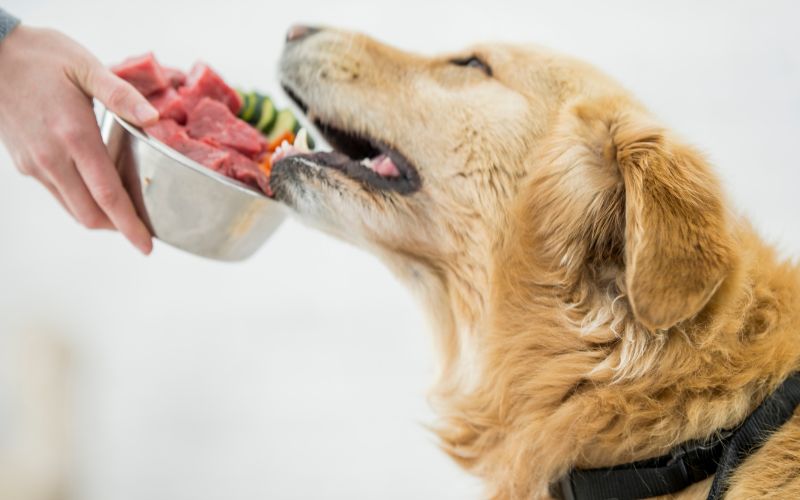Most dogs thrive on a high quality dried commercial dog food or a mix of raw food and food or kibble.
However, some people choose to feed their dog a raw diet due to the many benefits they claim it has for the dog.
Critics of a raw diet say that the risks of nutritional imbalance, intestinal problems and food-borne illnesses caused by handling and feeding raw meat outweigh any benefits.
However, owners who have transitioned their dog to a raw diet maintain that the benefits far outweigh any risks.
Many dogs on raw diets enjoy improved digestion, easier weight management, fresher breath, and healthier teeth and gums. Although a raw diet may not be suitable for every dog, owners who have made the switch report that their dogs enjoy increased energy levels, smaller and less smelly stools, and better overall health.
What is a raw diet
A raw diet is a type of canine diet that consists of feeding dogs raw, unprocessed foods.
This includes raw meats, bones, vegetables, and fruits.
Raw diets for dogs have become increasingly popular in recent years as more and more pet owners are looking for ways to improve their dog’s health.
Why do dogs like raw food?
There are a number of reasons why dogs may prefer raw food over other types of food.
Raw food is more natural and contains more nutrients than processed food.
It is also easier for dogs to digest and may help to improve their overall health.

What are the benefits of a raw diet?
There are many potential benefits of feeding a raw diet to dogs.
These benefits include improved digestion, easier weight management, fresher breath, and healthier teeth and gums.
Additionally, some owners report that their dogs enjoy increased energy levels and better overall health on a raw diet.
What are the risks associated with a raw diet?
There are some risks associated with feeding a raw diet to dogs.
These risks include the potential for nutritional imbalance, intestinal problems, and food-borne illnesses.
Additionally, owners must pay strict attention to hygiene when preparing a raw diet to avoid these risks.
Is a raw diet right for my dog?
A raw diet may not be suitable for every dog.
However, if you are considering switching your dog to a raw diet, it is important to consult with your veterinarian first to ensure that it is the right decision for your pet.
Is a raw diet suitable for every dog?
A raw diet is not suitable for every dog.
For example, puppies, pregnant or nursing dogs, and dogs with certain health conditions may not be able to tolerate a raw diet.
Additionally, owners must pay strict attention to hygiene when preparing a raw diet to avoid the risk of food-borne illness.
Consult with your veterinarian before switching your dog to a raw diet to ensure that it is the right decision for your pet.
Can a raw diet help a dog with allergies?
Raw diets are often touted as being helpful for dogs with allergies. However, there is no scientific evidence to support this claim.
Many dried commercial dog foods contain grains and other fillers that some dogs can be allergic to, and, for many, a switch to a raw based diet can help to alleviate and reduce adverse reactions to food.
What are some tips for transitioning my dog to a raw diet?
If you decide to transition your dog to a raw diet, there are a few things you should keep in mind.
First, introduce new foods slowly and in small amounts to avoid digestive upset.
Second, make sure that the food you are feeding is balanced and complete to ensure that your dog is getting all the nutrients they need.
Finally, pay attention to your dog’s stool quality and overall health to make sure that they are tolerating the diet change well.
[amazon box=”B0814ZXSVD” template=”horizontal” title=”Top Choice for Raw Dog Food”]
Can I feed my dog raw food every day?
Yes, you can feed your dog raw food every day.
However, it is important to ensure that the diet is balanced and complete to avoid nutritional deficiencies.
Additionally, pay attention to your dog’s stool quality and overall health to make sure that they are tolerating the diet well. If you have any concerns, consult with your veterinarian.
How much raw should I feed my dog?
The amount of raw food you should feed your dog will depend on their individual needs.
Split your dog’s daily food intake by 2-3% and feed him two meals per day.
A 20 Kg dog would require 500 to 750 grammes of raw dog food in each meal.
Active or working dogs may require more whereas less active dogs will, most likely, require less.
Can you mix raw food with dried dog food?
Yes, you can mix raw food with dried dog food and it is a good idea to do so.
By mixing the two, you can make sure that your dog is getting all the nutrients they need.
Additionally, it can help to transition your dog to a raw diet if they are not used to eating raw food.
What is the best way to store raw dog food?
Raw dog food should be stored in the fridge or freezer.
If you are using frozen raw food, thaw it in the fridge overnight before feeding it to your dog.
Do not leave raw food out at room temperature for more than two hours as this can cause bacteria to grow.
How long does raw dog food last?
Raw dog food will last for up to two days in the fridge or up to six months in the freezer.
However, it is best to use it within two days of opening it. Once thawed, raw dog food should be used within 24 hours.
What are the benefits of a raw diet for dogs?
Improved Digestion and Nutrient Absorption: Raw food diets typically consist of fresh meat, bones, organs, and vegetables. These ingredients closely resemble the natural diet of dogs’ ancestors. The raw diet is easily digestible and provides essential nutrients in a bioavailable form, which enhances digestion and nutrient absorption for optimal health.
Enhanced Dental Health and Stronger Jaws: Chewing on raw meaty bones helps to naturally clean a dog’s teeth and gums, reducing the risk of dental issues like tartar buildup, gum disease, and tooth decay. The chewing action also strengthens the jaw muscles and provides mental stimulation for dogs.
How does a raw diet benefit a dog’s overall health?
Healthy Skin and Shiny Coat: Raw food diets are rich in essential fatty acids, vitamins, and minerals, which promote healthy skin and a lustrous coat. These nutrients nourish the skin, reduce itching and allergies, and give the coat a glossy appearance.
Improved Energy and Vitality: A raw diet provides dogs with high-quality protein sources, promoting increased energy levels, stamina, and muscle development. The absence of fillers, additives, and artificial ingredients found in some commercial dog foods helps dogs maintain a healthy weight and overall vitality.
Reduced Allergies and Food Sensitivities: Many commercial dog foods contain common allergens such as grains, artificial preservatives, and additives. A raw diet eliminates these potential triggers, reducing the occurrence of allergies and food sensitivities in dogs. This can lead to improved gastrointestinal health and overall well-being.
Final Words
A raw diet is not suitable for every dog and there are some important things to keep in mind if you decide to switch your pet to this type of diet.
However, a raw diet can offer many benefits for dogs, including improved digestion and a shiny coat.
If you have any concerns, speak with your veterinarian before making any changes to your dog’s diet.




